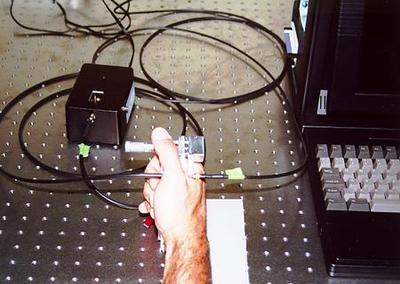New device may take sting out of glucose testing

This new non-invasive diabetes monitoring device, currently being tested at VUMC, could replace the painful skin prick method.
Investigators at the Vanderbilt Diabetes Center are testing a new blood sugar monitoring device that could make managing diabetes easier ‹ not to mention more comfortable.
The new device uses a non-invasive beam of light to measure glucose molecules in the web of skin between the patient's thumb and forefinger. The technique could, in the future, provide an alternative to the current standard method ‹ a painful skin prick to draw blood for glucose testing.
³People sometimes don¹t check their blood glucose because it is messy, inconvenient, and it hurts," said Dr. Stephen N. Davis, associate professor of Medicine. "This new machine would allow them to check it at any point to keep close track of the glucose levels.²
Current research indicates that medical care for patients who closely monitor their blood glucose levels is less costly than for patients who only rarely check their levels a few times a day, said Davis.
³The reason it is cheaper is that controlling blood glucose prevents many of the complications of diabetes, like blindness, kidney failure, nerve damage, heart attack and stroke."
A portion of the funding for Davis's research is being provided by the Mark Collie Celebrity Race for Diabetes Cure. The annual car race features celebrities from many different fields of entertainment and will be held this year on Oct. 8 at the Nashville Speedway. Country music singer Mark Collie, himself a diabetic, organized the charity event to provide funding for diabetes research.
Over the past three years the race has raised more than $500,000 for the Vanderbilt Diabetes Center so that scientists can continue promising research avenues.
Making it easier ‹ and less painful ‹ to check blood glucose levels is what led researchers to begin developing the new laser diagnostic machine.
Instead of a pinprick to extract blood to be examined, the monitoring device Davis is testing uses a beam of near-infrared light to 'look' at the blood while it's still in the body, in this case the flap of skin between the patient's thumb and forefinger. Computer analysis of the way the light reflects off the glucose molecules present helps determine the patient's blood sugar level.
³Although the device is in the testing phase, it has proven to be very accurate in animal models and could be on the market within two to three years,² said Davis.
Before then, Davis and other researchers must test the machine on patients of different ethnic groups and ages to be sure that it works the same on everyone.
³Because I think that this is such an important project, it is essential that the experiments be performed with the highest rigor,² said Davis.
After tests to determine the effectiveness in humans are complete, the device will be reconfigured and scaled down to a more practical and manageable size.
³Eventually the device will be the size of a hand-held tape recorder so that it is easier for patients to be more attentive to their blood sugar levels,² said Davis
Portability of design will have a huge impact on the ability of diabetics to manage their conditions, and their lives, Davis said. One of the most dangerous times for diabetics is during periods of exercise when their bodies burn up much of the available glucose. Hypoglycemia, or severe low blood sugar, can be triggered during such periods of exercise if patients do not keep close track of their blood sugar levels.
³With this device, people could check it between innings at a softball game and then take some lifesavers or drink some orange juice if they need to do that,² said Davis.













